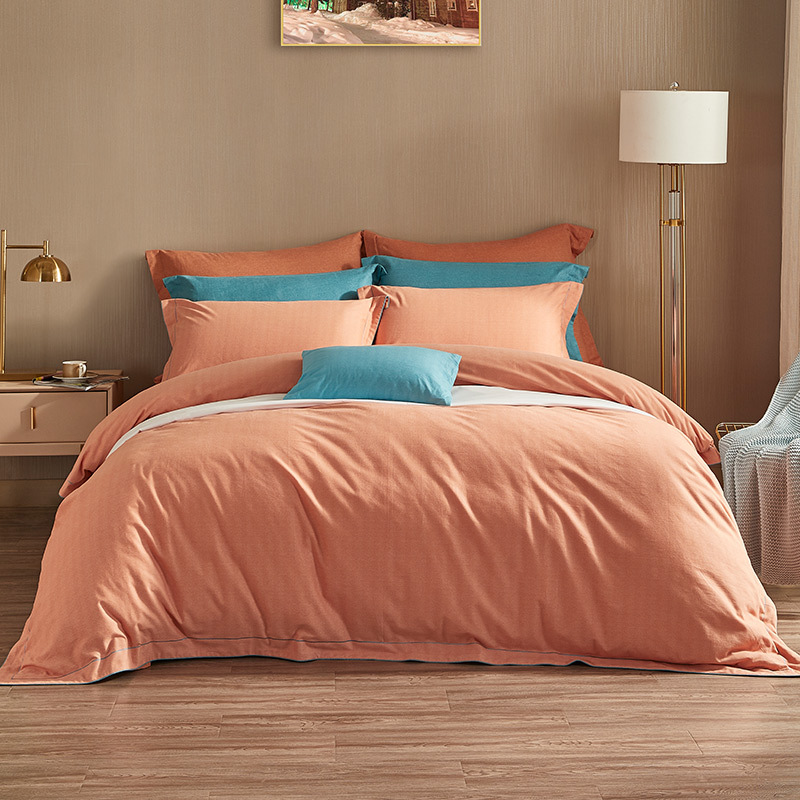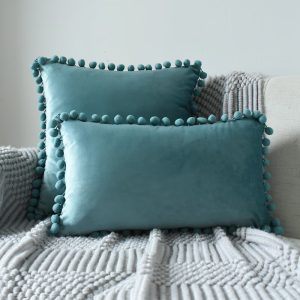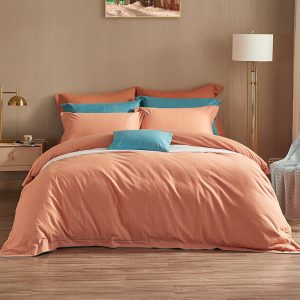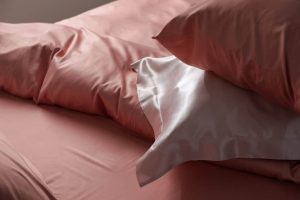When seeking the ultimate comfort experience in cotton bedding, a higher Thread Count (TC) does not always equal better quality. True comfort depends on the perfect balance of yarn quality, weaving craftsmanship, and density. Blindly chasing ultra-high thread counts often results in fabric that feels heavy, lacks breathability, and wears out faster. For most consumers and B2B buyers seeking that “five-star hotel” feel, a range of 300 TC to 600 TC woven from single-ply long-staple cotton is the optimal solution for balancing softness, breathability, and durability.
| Thread Count Range (TC) | Yarn Spec (S) | Tactile Feel | Recommendation | Best For |
|---|---|---|---|---|
| 200 – 300 TC | 40S | Crisp, cool, lightweight | ⭐⭐⭐⭐ | Summer, hot sleepers, economy hotels |
| 300 – 500 TC | 60S | Soft, smooth, balanced | ⭐⭐⭐⭐⭐ | The Sweet Spot, high-end homes, boutique hotels |
| 500 – 800 TC | 80S – 100S | Silky, dense, luxurious | ⭐⭐⭐⭐ | Luxury suites, lovers of high sheen |
| 1000+ TC | Double/Multi-ply | Heavy, stiff, poor airflow | ⭐⭐ | Marketing gimmicks, specific cold climate needs |
The Essence of Thread Count: Density vs. Weight
Thread Count (TC) refers to the total number of horizontal (weft) and vertical (warp) threads woven into one square inch of fabric. Theoretically, the finer the yarn, the more threads can be woven into the same area, resulting in a smoother surface. However, this is purely a measure of density, not absolute quality. When density increases beyond a certain point, the threads become packed too tightly, blocking airflow. This causes the fabric to feel heavy and stiff—like canvas—ultimately sacrificing comfort.

Converting 40S, 60S, and TC Values
In manufacturing terms, you often hear “40S,” “60S,” or “100S.” This refers to “Yarn Count” (S), which measures the fineness of the yarn. The higher the S value, the finer the yarn. While the US market focuses on TC, the two are closely related:
Generally, 40S yarn corresponds to 200-250 TC fabric; 60S yarn corresponds to 300-400 TC fabric; and extremely fine 80S or 100S yarn is required to weave high-density 500-800 TC fabric. Understanding this correlation is crucial because it is impossible to force thick yarn into a high-density weave, just as using ultra-fine yarn for low density results in flimsy fabric. VANY strictly adheres to these physical laws during production to ensure the best match between yarn thickness and density.
300-600 TC: Why It Is Called the “Golden Comfort Zone”
After countless lab tests and user feedback analysis, 300 TC to 600 TC is widely recognized as the “Golden Comfort Zone” for cotton bedding. Within this range, the fabric possesses enough density to ensure strength and a delicate touch, while retaining microscopic gaps between threads to ensure excellent breathability and moisture-wicking capabilities.
Bedding in this range, such as VANY’s 60S Long-Staple Cotton Sateen series, avoids the coarseness of low thread counts and the stifling heat of ultra-high thread counts. They are lightweight, drape beautifully, are easy to launder, and—crucially—the fibers soften with time, achieving a “better with every wash” quality.
Single-Ply vs. Multi-Ply: Exposing the 1000 TC Marketing Trap
Market products claiming 1000 TC or even 1500 TC often hide a “Multi-ply Yarn” trick. A genuine 1000 TC requires extremely fine yarns and advanced weaving technology, making it prohibitively expensive. To cut costs and create marketing buzz, some manufacturers twist 2 or even 3 strands of inferior short-fiber yarn together to act as one thread. For example, they weave 500 physical threads using 2-ply yarn but claim it is 1000 TC.
This multi-ply fabric is not only heavy and poorly breathable, but the uneven twist of the yarns also makes the surface prone to pilling. True luxury comes from the high count and high density of Single Ply yarn, not simply inflating numbers. VANY insists on transparency in product labeling, advocating for the pure texture of single-ply weaving.
Raw Material Limits: The Decisive Role of Long-Staple Cotton
Thread count is a quantitative change; raw material is a qualitative change. A 400 TC fabric made from standard upland cotton feels vastly different from one made with Egyptian Cotton or Pima Cotton. Long-staple cotton fibers exceed 31.8mm in length, resulting in spun yarn with fewer connection points, a smoother surface, and higher tensile strength.
Lower-grade cotton, even woven into a high thread count, will feel rough due to short fibers poking out and will stiffen rapidly after washing. Therefore, before asking “how many threads,” asking “what kind of cotton” is critical. Premium long-staple cotton supports the spinning of finer yarns, forming the foundation for high-quality 60S or 80S fabrics.
Percale Weave: The Crisp Choice for Low Thread Counts
For those who love the crisp, cool feeling of a “freshly laundered shirt,” Percale is the best choice. Percale uses a one-over-one weave structure that is matte and durable. Because the weave is tight, Percale does not typically require extremely high thread counts; 200 TC to 400 TC Percale bedding performs best.
In this range, Percale bedding offers superior airflow, making it a savior for hot sleepers and those in warm climates. Excessively high thread counts can actually ruin the signature crispness of Percale, making it too dense to breathe.
Sateen Weave: The Silky Sheen of High Thread Counts
Sateen uses a floating structure (usually four-over-one), exposing more thread surface to reflect light, creating a silk-like luster. The Sateen structure is looser, requiring a higher thread count to maintain fabric stability. 300 TC is the entry standard for Sateen, while 500 TC to 600 TC represents the pinnacle of Sateen luxury.
In this range, Sateen bedding feels buttery soft, has excellent drape, and retains heat slightly better than Percale, making it ideal for cooler seasons or users who prefer a silky touch against the skin. VANY’s Sateen series undergoes mercerization pre-treatment to further enhance this premium luster.
The Breathability Paradox: How High Density Affects Sleep Temp
Many assume “more expensive (higher TC) means more comfortable,” ignoring breathability. The body breathes and releases moisture during sleep. When the thread count exceeds 800 TC, threads fill every available gap, forming a nearly sealed barrier. Heat and moisture get trapped under the covers, leading to night sweats.
The most comfortable sleep micro-climate should remain dry and temperature-regulated. This is why 60S (approx. 300-400 TC) fabric is the most popular choice in high-end hotels—it finds the perfect physical balance point between delicate texture and thermal comfort.
Durability Factors: Is Thinner Weaker or Is Thicker Stronger?
Fabric durability is not solely determined by thickness. While 1000 TC multi-ply fabric is thick, it often tears easily due to inconsistent fiber quality. Conversely, a 300-600 TC single-ply fabric made from premium long-staple cotton may feel lighter, but the fiber toughness is immense, resisting tearing and withstanding frequent washing.
Especially in commercial laundry environments, excessively high thread counts mean the fabric is harder to clean deeply and takes longer to dry, increasing maintenance costs. Choosing premium cotton with a moderate thread count significantly extends the product’s Life Cycle, making it a more cost-effective choice for B2B sourcing.
VANY OEM Standards: Real Quality Without False Labeling
In a chaotic home textile market, VANY adheres to a “What You See Is What You Get” OEM manufacturing standard. We offer full customization from 200 TC to 800 TC, strictly controlling the raw material matching behind every thread count. If you seek ultimate cost-performance, we recommend 40S/250 TC; if you seek a flagship experience, we provide 80S/600 TC long-staple cotton solutions.
Through precise spinning and finishing processes (like singeing), we eliminate surface fuzz, ensuring that even our standard 300 TC models present superior softness. At VANY, we believe the best thread count isn’t the highest number on the tag, but the specific value that best suits your target market and sleep habits.



